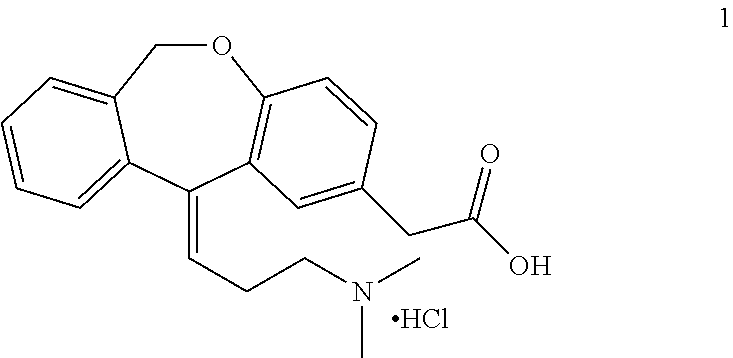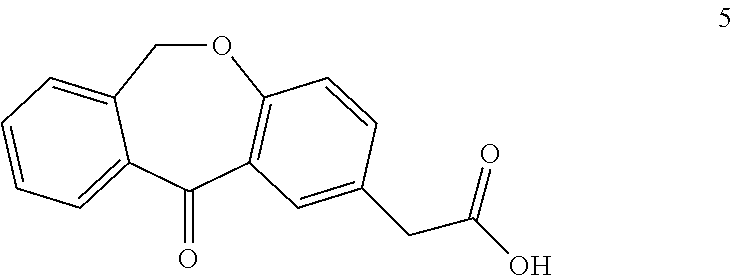A process for the synthesis of olopatadine
a technology of olopatadine and synthesis process, which is applied in the field of synthesis process of olopatadine, can solve the problems of iodination less attractive from commercial standpoint, long process cycle, and low yield of preferred z isomer, and achieve the effect of improving the yield of the preferred z isomer
- Summary
- Abstract
- Description
- Claims
- Application Information
AI Technical Summary
Benefits of technology
Problems solved by technology
Method used
Image
Examples
example 1
[0040]2-(11-oxo-6,11-dihydrodibenzo[b,e]oxepin-2-yl)acetic acid (5 g, 18.65 mmol) was dissolved in methanol (100 mL) and cooled at 0° C. Thionyl chloride (2.06 mL, 27.98 mmol) was added dropwise during a half hour period and the solution was stirred at room temperature (25° C.) for 24 h. The solvent was evaporated almost to dryness and the residue was partitioned between dichloromethane (50 mL) and saturated sodium bicarbonate solution (50 mL). The organic layer was dried over anhydrous Na2SO4, filtered and concentrated under reduced pressure, giving ketoester, which was used without further purification.
example 2
[0041]To a stirred mixture of Isoxepac ester (5 g, 17.66 mmol) and zinc (3.44 g, 53 mmol) in DMF (50 mL), allyl bromide (1.66 mL, 19.43 mmol) was added at 0° C. After 2 hours the reaction mixture was filtered to remove the remaining zinc, 10% hydrochloric acid (20 mL) was added and organic layer was separated. The aqueous layer extracted with small portions of EtOAc, the combined organic extracts were dried over Na2SO4 and concentrated in vacuo. The resulting liquid was purified by column chromatography (pet ether-ethyl acetate, 8:2) to give compound 4 (5.2 g, 91%) as thick colorless oil.
[0042]Colorless liquid; 1H NMR (200 MHz, CDCl3+CCl4): δ 2.86-2.97 (m, 1H), 3.34-3.44 (m, 1H), 3.60 (s, 2H), 3.68 (s, 3H), 5.04 (d, J=15.5 Hz, 1H), 5.09-5.18 (m, 2H), 5.47 (d, J=15.5 Hz, 1H), 5.35-5.56 (m, 1H), 6.90-7.00 (m, 1H), 7.06 (d, J=8.09 Hz, 1H), 7.15-7.31 (m, 3H), 7.56 (d, J=2.15 Hz, 1H), 7.94-7.84 (m, 1H); 13C NMR (50 MHz, CDCl3+CCl4): δ 40.5, 48.7, 51.8, 73.6, 75.7, 119.4, 121.3, 125.8, 12...
example 3
[0043]At first, 9-BBN (1.80 g, 14.81 mmol) was added to a well stirred solution of olefin 4 (4 g, 12.34 mmol) in anhydrous THF (40 mL) at room temperature (25° C.) and the reaction mixture was stirred for 24 h at 70° C. Then the reaction mixture was quenched with 3 M NaOH (0.54 g, 13.50 mmol) at 0° C., followed by the dropwise addition of 30% H2O2 (3.5 mL, 37.03 mmol) and the resulting solution was stirred for 6 h at room temperature (25° C.). The organic phase was separated and the aqueous layer extracted with ethyl acetate (3×20 mL). The combined organic phase was washed with brine (1×30 mL), dried over anhydrous Na2SO4, and the solvent was evaporated under reduced pressure. The crude product was subjected to flash column chromatography (pet ether-ethyl acetate, 7:3) to obtain diol 6 (3.54 g, 84%).
[0044]Colorless liquid; 1H NMR (200 MHz, CDCl3+CCl4): δ 1.20-1.56 (m, 2H), 2.08-2.28 (m, 1H), 2.64-2.89 (m, 1H), 3.36-3.64 (m, 4H), 3.67 (s, 3H), 4.84 (brs, 1H), 5.01 (d, J=15.4 Hz, 1H),...
PUM
| Property | Measurement | Unit |
|---|---|---|
| temperature | aaaaa | aaaaa |
| temperature | aaaaa | aaaaa |
| temperature | aaaaa | aaaaa |
Abstract
Description
Claims
Application Information
 Login to View More
Login to View More - R&D
- Intellectual Property
- Life Sciences
- Materials
- Tech Scout
- Unparalleled Data Quality
- Higher Quality Content
- 60% Fewer Hallucinations
Browse by: Latest US Patents, China's latest patents, Technical Efficacy Thesaurus, Application Domain, Technology Topic, Popular Technical Reports.
© 2025 PatSnap. All rights reserved.Legal|Privacy policy|Modern Slavery Act Transparency Statement|Sitemap|About US| Contact US: help@patsnap.com



